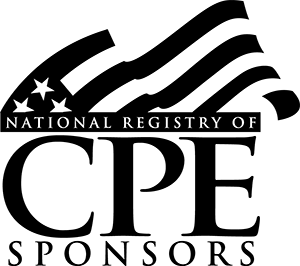What Sponsors Need to Know
The Most Common Compliance Audit Failure: Group Live Attendance Monitoring
Paragraph S16-02 of the Statement on Standards for Continuing Professional Education (CPE) Programs (Standards) states that CPE program sponsors must maintain a process to monitor individual attendance at group programs to assign the correct number of CPE credits.
The most common audit failure of compliance audits has been inadequate attendance monitoring policies coupled with insufficient attendance monitoring documentation for the group live delivery method.
Why the emphasis on attendance monitoring and documentation? CPAs must report CPE credits to Boards of Accountancy in order to maintain and renew their licenses. Typically, state boards only review the certificate of completion, so it’s vital that attendance procedures support the assignment of CPE credits as reflected on the issued certificate.
The key is to have attendance monitoring procedures and documentation that are adequate and sufficient such that, if contacted four months after the date of the program, a sponsor could re-issue the certificate with confidence as to the individual’s attendance and the correct amount of CPE credit earned at the program. When there are concerns about the attendance monitoring process, this may raise a red flag about the validity of the CPE credits.
Listed below are the most common deficiencies in this area and guidance on how to remedy the deficiencies.
The supporting documentation does not match the attendance monitoring procedures as described by the sponsor on the audit form.
Example
Sponsor described the attendance monitoring policy as using sign-in sheets and a room monitor. The submitted documentation was a registration list with no individual signatures and no attestation from the room monitor.
Corrective Action
In this situation, the expectation is to review the actual sign-in and sign-out sheet containing individual signatures. The room monitor should include an attestation on the form, or the sponsor should clearly explain how the room monitor accounts for attendance on the audit form.
The supporting attendance documentation is incomplete.
Example
Sponsor used a scanning system and mobile application to monitor attendance. The scanning system only captures a scan-in time. The scanning system does not capture a duration time or a time out.
Corrective Action
In this situation, the scanning report is not sufficient as it lacks duration and time-out stamps and details on how the document is used to monitor late arrivals, early departures and extended breaks.
Sponsor allows the CPA to self-report CPE credits.
Example
This is commonly done using CPE forms that allow the CPA to check a box certifying they were in attendance for specific sessions.
Corrective Action
A participant’s self-certification of attendance alone is not sufficient. The sponsor must have a policy to monitor individual attendance to assign the correct number of CPE credits. A sponsor could add procedures, such as requiring attendees to record key words during training sessions, stickers provided at the conclusion of breakout sessions to include on the form as indication of attendance, or combine registration procedures with room monitoring.
The written attendance policy lacked sufficient detail.
Example
The sponsor stated that they only use sign-in sheets.
Corrective Action
This attendance policy is insufficient. It does not provide the necessary details to understand how the sponsor is monitoring attendance. The policy should be expanded to detail if the participant must sign-in and sign-out at the beginning and conclusion of the program. Are there facilitators or room monitors present to verify that extended absences do not occur? How are late arrivals and early departures accounted?
Rev. Date 04/13/2020

